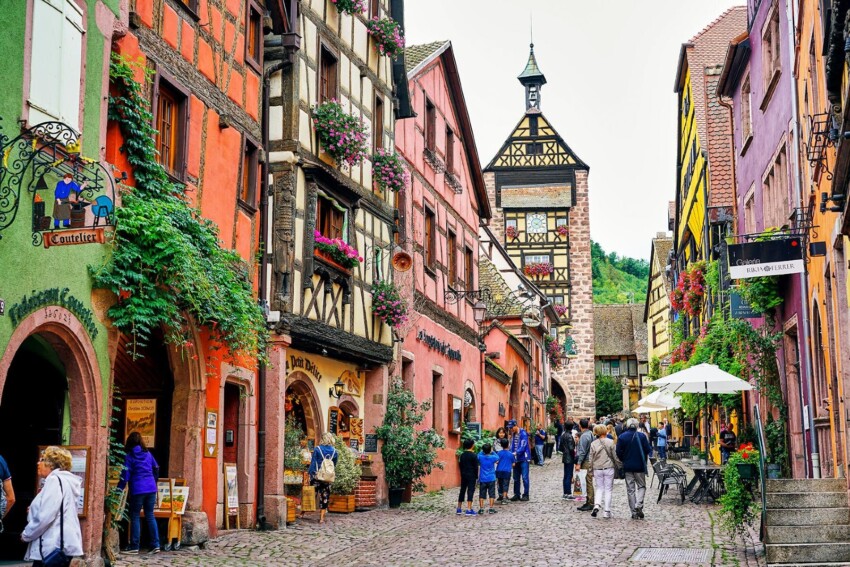

Concealed within a double circle of walls is one of Alsace’s most charming jewelled villages, Riquewihr. The village looks like something out of a storybook, and that’s not a figure of speech.
If its narrow, cobbled streets, picturesque and colourful half-timbered houses, tower and fountain remind you of anything, it is no coincidence. Riquewihr inspired Disney illustrators to design the village of Belle, the protagonist of the animated feature Beauty and the Beast.
This tiny village of just 1,200 inhabitants is a treasure trove of wonder and beauty, set in an enchanting hilly landscape covered in vineyards. It contains all the characteristics of medieval Alsatian villages: bubbling fountains, small houses with sloping roofs and half-timbered façades in endless pastel shades, craftsmen’s workshops and many wine cellars, where seven fantastic wines, including riesling, are produced.

This enchanting village should be explored unhurriedly, taking your time to admire the carved details of the façades, wandering through the narrow side streets and looking for courtyards hidden from the view of hurried visitors.
Built in 1809 on the spot where the lower gate of the Old Town of Riquewihr once stood, today the town hall is the starting point for visiting the village.
After passing through the archway in the centre of the town hall, it is immediately apparent that the building served both as a defence and as the main entrance to the town. A few steps away is the fountain immortalised in the film Beauty and the Beast: here, the protagonist Belle stops to read a book surrounded by a beautiful village.
This long, uphill street is the main artery of the city and you can admire many beautiful old houses. Standing out among them all is La Maison de Hansi2 one of the tallest half-timbered houses in all of Alsace.
Then you will encounter, at number 12, La Maison Irion3, dating from the 17th century: note its graceful corner balcony.
On the other hand, Maison Preiss Zimmer4 once housed the very old Locanda della Stella, dating from 1686. Also not to be missed is the Maison Liebrich (1535): in the picturesque courtyard with its wooden galleries and balustrades is a well from 1603 and a huge wine press from 1817. Of note, directly opposite, is the Behrel House with a graceful oriel from 1514 surmounted by a part added in 1709.
Also of interest are the Winegrower’s House, dating back to the 16th century, the house known as Au Bouton d’Or and the Maison du Maire Eberlin.
Don’t hesitate to slip into the adjoining alleyways, letting the colours and fairytale atmosphere of these hidden streets guide you. You will be struck by the beauty and meticulous care that the villagers lavish on their private homes and shops, especially in spring, with flowers of every colour, and at Christmas, with wonderful decorations on all the windows.
Among the many enchanting shops in the centre, we would like to point out Féerie de Noël, a magical village dedicated to Christmas: it offers a variety of more than 20,000 items on display over an area of almost 300 square metres. Nothing has been overlooked to decorate the interior and infuse it with the magic of Christmas. Over 3 km of garlands, more than 5,000 small lamps illuminate the place. An unforgettable visit.
At 25 metres high, the ancient tower dominates and protects the town: it once served as a lookout point for enemies and a strategic place for the defence of the town. The tower has an unusual peculiarity: from outside the town walls, it has all the characteristics of an imposing defensive structure with a massive façade and narrow loopholes, while from inside the town, it takes on the appearance of a four-storey high dwelling with flowered windows and wooden decorations.
Today, the tower houses the Historical Museum of Folk Art and Tradition, where weapons and tools dating back to the 15th century can be admired.
Beyond the tower rises the Upper Gate: it was built in the 16th century to reinforce the city’s military defences.
At one time, the gate was equipped with a drawbridge that served to defend the city from enemy attacks: part of the structure can be glimpsed today.
This unusual museum, built in a former pentagonal defence tower about 18 metres high, will allow you to take a plunge into the town’s medieval past: visit the prison with its torture chamber, interrogation room, dungeon and guards’ room. The premises were used from the 14th century until the mid-20th century.
In the following map you can see the location of the main places of interest mentioned in this article.

During the Christmas season, Riquewihr is cloaked in a fairy-tale charm and seems straight out of a Christmas fairy tale. The entire village is transformed into an enchanted village, with lights, decorations and illuminations on every single façade in the centre.
Not to be missed is the Christmas market that winds its way through the village and its side squares: you will find small wooden stands with the best of local gastronomy and handicrafts.
For the occasion, the town’s wine cellars also open to visitors and host workshops for all ages, along with tastings of delicious local wines.
The village of Riquewihr is really tiny. For this reason, accommodation options are few and at quite high prices, especially in connection with major events such as the Christmas markets.
Instead, there are many sought-after accommodations just outside the village, surrounded by vineyards and often equipped with spas for a relaxing stay.
A solution to have more choice and save on rates may be to stay in the nearby towns of Colmar, Strasbourg or Mulhouse.
What's the weather at Riquewihr? Below are the temperatures and the weather forecast at Riquewihr for the next few days.
Riquewihr is about 50 minutes' drive from Strasbourg and only 20 minutes from Colmar.